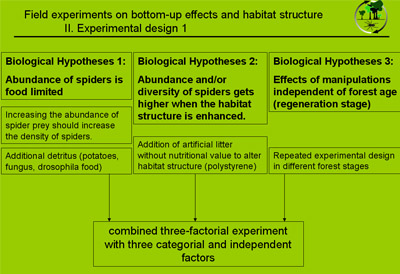Fieldexperiments
on the effects of nutrition enhancement and manipulation of habitat structures on the epigeic spider community in an Atlantic Rainforest region in Southern Brazil.
Regarding the aim of the SOLOBIOMA-Project to evaluate different secondary-growth habitats in their potential to host the regional biodiversity it is of great importance to get to know more about the impact of environmental variables.
What variables influence the ground spider assemblage?
- Are the diversity and the abundance of spiders limited by nutrient resources or by habitat space?
- Is the Influence of these two factors different in different forest stages?
- Could spiders be suitable indicators due to their dependency to the habitat?
- Is there a difference between tropical and temperate regions?
Due to the special condition in the usually poor tropical soils and because of the nutritional changes in secondary forests it should be of interest to address these interactions with the investigated fauna and try to answer some of these basic but important questions.
That is why we did a field experiment addressing the mentioned Questions in 2008 in the “Reserva Natural do Rio Cachoeira”. We added in 2 different forest stages (A & F) artificial habitat structures (Styropor) and additional food resources in a highly replicated experimental design.

Experimental design

Fieldexperiment-Team